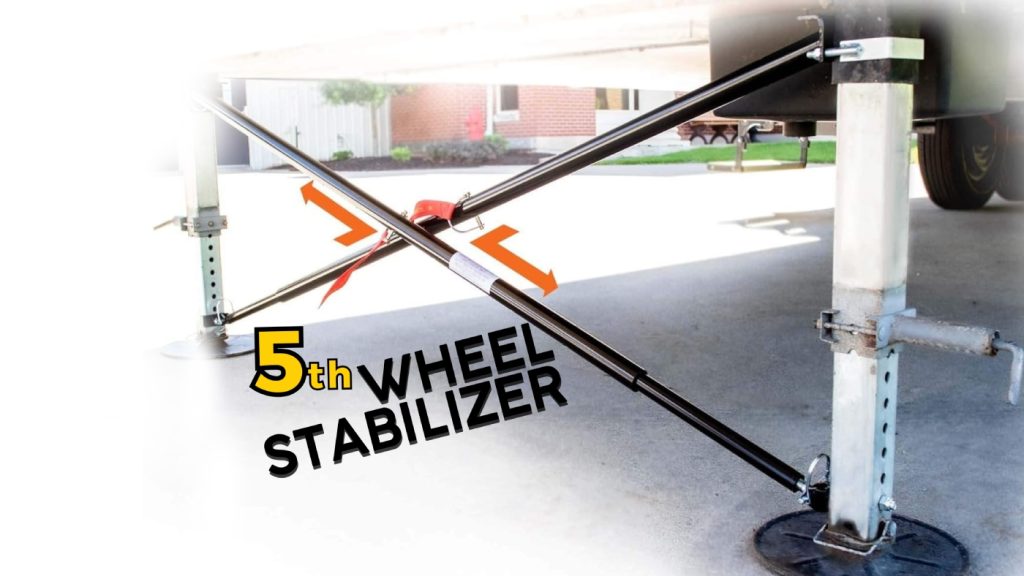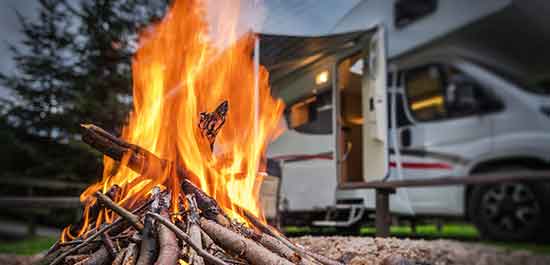Last Updated on January 21, 2025
Yes, fifth wheel stabilizers do work effectively to enhance your RV’s stability. When installed correctly beneath the kingpin, they minimize wobble and shaking, providing a more comfortable living environment. These stabilizers distribute weight evenly, particularly in the nose area, which is essential for overall balance.
While they help considerably, recognize that they may not completely eliminate all movement, especially on uneven terrain. For best results, combine them with other equipment like wheel chocks and leveling jacks. If you’re looking to optimize your setup, there’s much more to uncover about stabilizers and their benefits.
Key Takeaways
- Fifth wheel stabilizers significantly reduce wobble and shaking, enhancing overall comfort and security inside the RV.
- They distribute weight evenly under the kingpin, protecting internal components and improving stability.
- Various types of stabilizers, such as tripod and scissor jack, cater to different stability needs and trailer weights.
- Proper installation and regular maintenance are essential for optimal performance and long-term effectiveness.
- Combining stabilizers with wheel chocks and leveling jacks further enhances RV stability on uneven terrain.
Understanding Fifth Wheel Stabilizers
Stabilizers, positioned under the kingpin, reduce wobble and shaking by distributing weight evenly, particularly in the nose area. They complement hydraulic jacks located at the RV’s corners, ensuring that your unit remains level, which is vital for safety and preventing uneven wear. Tripod stabilizers primarily support the overhang of fifth wheels and are beneficial for individuals sensitive to floor movements.
While stabilizers provide additional support on uneven terrain, they may not eliminate wobble entirely. Factors such as RV weight, leveling procedures, and the specific stabilizer model impact effectiveness.
Types of Stabilizers Available
Stabilizers come in various types, each designed to address specific stability needs for fifth wheel RVs. Understanding these options helps you choose the best solution for your setup.
Here are three main categories:
- Standard Stabilizers: Includes tripod, scissor jack, and bar-style stabilizers, which prevent movement and enhance stability.
- Hydraulic Stabilizers: Features advanced systems like 6-point leveling and pump-controlled options that automate and refine leveling processes. These systems may require installation modifications for optimal performance.
- Fifth Wheel Specific Stabilizers: These include X-brace and hitch mount stabilizers, designed for targeted support at vital points of your RV.
Key Benefits of Stabilizers
When you install a fifth wheel stabilizer, you’ll notice a significant reduction in movement, making your living space feel more secure. The easy installation process means you can set it up quickly without complicated tools or modifications. With these benefits, stabilizers enhance both comfort and safety during your travels.
Additionally, they help distribute weight evenly across the RV frame, further enhancing stability and protecting internal components from damage.
Movement Reduction Efficiency
Although many factors contribute to the stability of a fifth wheel, the addition of stabilizers can dramatically enhance movement reduction efficiency. Stabilizers considerably mitigate swaying and bouncing, often cutting movement by half or more.
Here are three key benefits:
- Enhanced Support: Stabilizers like the FastJack King Pin Stabilizer and Husky 5th Wheel Stabilizer provide essential support to the trailer’s structure, reducing front-to-back and side-to-side movement. The King Jack tripod stabilizer is specifically designed for front kingpin stabilization, effectively reducing bounce and shake.
- Terrain Adaptability: Adjustable stabilizers cater to various terrains, ensuring ideal leveling and stability even on uneven surfaces.
- Easy Installation: Most stabilizers are straightforward to install and adjust, allowing you to achieve effective stabilization with minimal effort.
Enhanced Living Security
The use of fifth wheel stabilizers not only reduces movement but also considerably enhances living security within your RV. By minimizing wobble and guaranteeing even weight distribution, these stabilizers create a more comfortable and stable environment.
You’ll notice reduced shaking, especially in the nose area, which is essential for restful living and sleeping conditions. Additionally, testing has shown that the stabilizers can lead to a notable reduction in motion during use.
The stabilizers provide additional support to the kingpin, boasting a robust load rating for reliability. Their durable construction guarantees longevity, while secure positioning prevents collapse. With regular maintenance and proper usage, you can prevent damage to your RV’s structure, assuring long-term stability and safety.
Easy Installation Process
Installing fifth wheel stabilizers is a straightforward process that greatly enhances your RV experience. You’ll find that the ease of installation allows you to set up quickly and efficiently. Here are three key benefits:
- Time-Saving: Quick setup reduces your overall preparation time.
- Adjustability: Simple screw adjustments help you achieve precise leveling on various surfaces.
- User-Friendly: Clear instructions make it accessible, even for those new to RV maintenance. Additionally, with the ability to expand from 40 to 70 inches, the stabilizers can accommodate different RV sizes and configurations.
The installation typically involves securing the stabilizers to the underside of your fifth wheel and aligning them with the landing jacks. With common tools like drills and wrenches, you can enjoy a stable RV environment without hassle. Remember to check that the area is clear and the RV is level before starting the process.
Proper Installation Techniques for Fifth Wheel Stabilizers
When installing fifth-wheel stabilizers, proper leveling of your RV is essential for effective performance. Pay attention to stabilizer placement and guarantee you adjust the height correctly to achieve ideal stability.
Leveling the RV
Achieving a level RV is essential for comfort and stability, and there are several effective techniques to guarantee it’s done correctly. Here are three methods you can use:
- Leveling Blocks: Use a bubble level to check the RV’s levelness. Position leveling blocks under the tires, driving onto them for side-to-side adjustments. Recheck with the bubble level and adjust as needed. Proper leveling is crucial for the safe operation of slide-outs and helps reduce wear on tires and suspension systems.
- Hydraulic Leveling Systems: If your RV has a hydraulic system, consult the manual for specific instructions. Use the control panel to raise low corners automatically.
- Fifth Wheel or Travel Trailer: Position your RV close to the final spot. Use a level to check side-to-side adjustments, then use the A-Frame Jack for front-to-back leveling before deploying stabilizer jacks.
Stabilizer Placement Tips
After leveling your RV, proper placement of stabilizers is key to maximizing stability and minimizing movement.
Start by measuring the center line between the two jacks, using a reference point either at the front or back of the fifth wheel. Position your mounting brackets slightly forward or backward from the center line, which doesn’t affect performance.
Mark the center line and measure one inch in both directions to determine ideal bracket positions. Temporarily secure the foot of the stabilizer bar to the jack with cable ties or tape for accurate positioning.
Finally, bolt the brackets in place, ensuring the ratchet is free-moving before lowering the jacks to achieve a stable setup. Proper placement enhances effectiveness and safety. Using stabilizers like the JT Strongarms or Steadyfast system can dramatically improve stability while parked.
Height Adjustment Importance
Height adjustment is essential for ensuring the stability of your fifth wheel RV. Accurate height adjustment prevents inadequate stabilization, which can lead to safety issues. Follow these key steps for proper installation:
- Park on a level surface and engage the parking brakes.
- Extend the stabilizer until it firmly contacts the kingpin, then fine-tune the height using screw adjustments.
- Lock the stabilizer in place to secure your setup. Using a bottle jack can be beneficial for achieving the correct height and stability.
Using a bubble level inside the RV can help you confirm correct pin loading, ensuring the trailer is slightly nose down for ideal weight distribution.
Comparing Stabilizer Options
When you’re looking to stabilize your fifth wheel, understanding the various stabilizer options available can greatly influence your comfort and safety during your travels. Here’s a comparison of popular stabilizer types:
| Stabilizer Type | Key Features |
|---|---|
| Tripod Stabilizers | Easy to install, effective against side-to-side movement, up to 7,500 lbs. |
| SteadyFast Stabilizers | Permanently installed, excellent against movement, supports 6,000 lbs. |
| Scissor Jack Stabilizers | Adjustable, good for vertical stability, up to 7,500 lbs. |
| Universal/X-Brace | Easy installation, locks out side-to-side movement, heavy-duty use. |
Each stabilizer serves distinct purposes, so choose based on your specific needs and weight requirements to guarantee maximum stability during your adventures.
Addressing Common Concerns
How effective are fifth-wheel stabilizers in real-world conditions? Their performance hinges on several factors, including your trailer’s weight and the terrain.
Tripod stabilizers enhance stability by distributing weight under the kingpin, but they may not eliminate all wobble, especially with longer models. Additionally, stabilizers can help maintain proper tire pressure by reducing the load on the tires during stationary use.
Consider these key points:
- Installation: Most stabilizers, like MORryde’s 5th Wheel Stabilizer, are easy to install and stay in place during travel.
- Maintenance: Regular inspections guarantee proper functionality, vital for long-term stability.
- Combination Methods: Pairing stabilizers with wheel chocks and leveling jacks can greatly boost stability. Stabilizers can mitigate movement and enhance comfort inside the RV, making them an essential component of your setup.
Frequently Asked Questions
Can Stabilizers Be Used on All Types of RVS?
Over 70% of RV owners report improved stability when using stabilizers. You can use various stabilizers on different types of RVs, but compatibility is key. For instance, tripod stabilizers are designed specifically for fifth wheels, while wheel chocks work across all RV types.
Always consider your RV’s weight and design when choosing stabilizers. Proper setup, including leveling blocks and jacks, enhances stability, ensuring a safer and more comfortable experience.
How Much Weight Can Stabilizers Support?
Fifth wheel stabilizers typically support a standard certified load capacity of 5,000 pounds. They’re designed to stabilize the front of your trailer at king pin heights between 38 and 53 inches. You can make major adjustments by moving the foot pads and minor ones at the screw level.
Remember, these stabilizers aren’t meant to lift your trailer; they’re primarily for minimizing bounce and rocking when you’re moving inside. Always use them correctly for safety.
Are Stabilizers Effective on Uneven Surfaces?
Stabilizers are quite effective on uneven surfaces when used correctly. They help distribute weight evenly, reducing unwanted motion and vibrations. For maximum performance, you should combine stabilizers like king pin stabilizers with leveling blocks or pads. This combination provides solid support and minimizes sway, especially in challenging terrains.
Always verify the stabilizers are properly tightened, as over-tightening can lead to damage, compromising their effectiveness in maintaining stability.
Do Stabilizers Require Maintenance Over Time?
Just like a well-oiled machine, stabilizers need maintenance over time to function effectively. You should regularly clean and lubricate them, inspect for damage, and guarantee all components are in good shape.
Performing checks every 90 days or after heavy use keeps them reliable. Store them properly and follow the manufacturer’s guidelines to avoid issues. Neglecting maintenance could lead to decreased performance and safety risks, so stay proactive!
Can I Install Stabilizers Myself or Hire a Professional?
You can definitely install stabilizers yourself, provided you have the right tools and materials. Begin by determining the type needed for your RV’s weight and terrain. Follow a clear design plan, guaranteeing proper measurements and alignment during installation.
Though it can be a DIY project, hiring a professional might save time and guarantee peak performance. If you’re confident in your skills, DIY stabilizers can be a cost-effective solution that enhances stability.
Smooth Journeys Ahead: Choosing the Right Stabilizer for Your Fifth Wheel Adventure
To summarize, fifth wheel stabilizers truly enhance your towing experience by reducing sway, improving safety, and increasing comfort. By choosing the right type, ensuring proper installation, and understanding their benefits, you’re set for a smoother journey.
Whether you prefer a tripod, scissor, or electric stabilizer, each option can provide the stability you need. So, embrace the advantages, invest wisely, and enjoy the peace of mind that comes with a well-supported fifth wheel.



